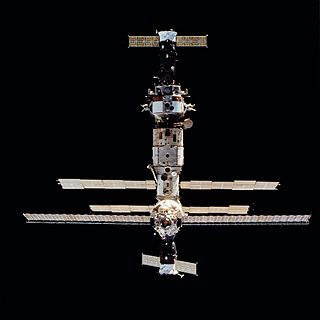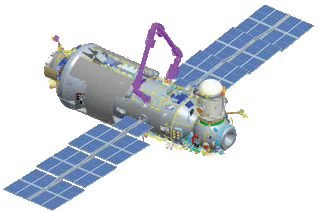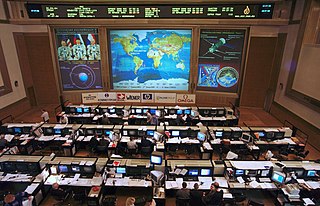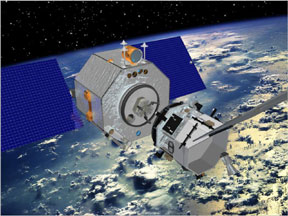
The Mobile Servicing System (MSS), is a robotic system on board the International Space Station (ISS). Launched to the ISS in 2001, it plays a key role in station assembly and maintenance; it moves equipment and supplies around the station, supports astronauts working in space, and services instruments and other payloads attached to the ISS and is used for external maintenance. Astronauts receive specialized training to enable them to perform these functions with the various systems of the MSS.

STS-57 was a NASA Space Shuttle-Spacehab mission of Space ShuttleEndeavour that launched June 21, 1993, from Kennedy Space Center, Florida.

STS-61 was NASA's first Hubble Space Telescope servicing mission, and the fifth flight of the Space Shuttle Endeavour. The mission launched on December 2, 1993, from Kennedy Space Center (KSC) in Florida. The mission restored the spaceborne observatory's vision with the installation of a new main camera and a corrective optics package (COSTAR). This correction occurred more than three and a half years after the Hubble was launched aboard STS-31 in April 1990. The flight also brought instrument upgrades and new solar arrays to the telescope. With its very heavy workload, the STS-61 mission was one of the most complex in the Shuttle's history.

STS-63 was the second mission of the US/Russian Shuttle-Mir Program, which carried out the first rendezvous of the American Space Shuttle with Russia's space station Mir. Known as the 'Near-Mir' mission, the flight used Space Shuttle Discovery, which lifted off from launch pad 39B on February 3, 1995, from Kennedy Space Center, Florida. A night launch and the 20th mission for Discovery, it marked the first time a Space Shuttle mission had a female pilot, Eileen Collins, and the first EVAs for both a UK born astronaut, Michael Foale, and a US astronaut of African heritage, Bernard A. Harris, Jr. It also carried out the successful deployment and retrieval of the Spartan-204 platform, along with the scheduled rendezvous and flyaround of Mir, in preparation for STS-71, the first mission to dock with Mir.

STS-87 was a Space Shuttle mission launched from Launch Complex 39B of the Kennedy Space Center on 19 November 1997. It was the 88th flight of the Space Shuttle and the 24th flight of Columbia. The mission goals were to conduct experiments using the United States Microgravity Payload (USMP-4), conduct two EVAs, and deploy the SPARTAN-201 experiment. This mission marked the first time an EVA was performed from Columbia. EVAs from Columbia were originally planned for STS-5 in 1982 and STS-80 in 1996, but were canceled due to spacesuit and airlock problems, respectively. It also marked the first EVA conducted by a Japanese astronaut, Takao Doi.

Canadarm or Canadarm1 is a series of robotic arms that were used on the Space Shuttle orbiters to deploy, manoeuvre, and capture payloads. After the Space Shuttle Columbia disaster, the Canadarm was always paired with the Orbiter Boom Sensor System (OBSS), which was used to inspect the exterior of the shuttle for damage to the thermal protection system.

Dextre, also known as the Special Purpose Dexterous Manipulator (SPDM), is a two-armed robot, or telemanipulator, which is part of the Mobile Servicing System on the International Space Station (ISS), and does repairs that would otherwise require astronauts to do spacewalks. It was launched on March 11, 2008, on the mission STS-123.

The European Robotic Arm (ERA) is a robotic arm that is attached to the Russian Orbital Segment (ROS) of the International Space Station. Launched to the ISS in July 2021; it is the first robotic arm that is able to work on the Russian Segment of the station. The arm supplements the two Russian Strela cargo cranes that were originally installed on the Pirs module, but were later moved to the docking compartment Poisk and Zarya module.

A robonaut is a humanoid robot, part of a development project conducted by the Dexterous Robotics Laboratory at NASA's Lyndon B. Johnson Space Center (JSC) in Houston, Texas. Robonaut differs from other current space-faring robots in that, while most current space robotic systems are designed to move large objects, Robonaut's tasks require more dexterity.

Flight controllers are personnel who aid space flight by working in such Mission Control Centers as NASA's Mission Control Center or ESA's European Space Operations Centre. Flight controllers work at computer consoles and use telemetry to monitor various technical aspects of a space mission in real-time. Each controller is an expert in a specific area and constantly communicates with additional experts in the "back room". The flight director, who leads the flight controllers, monitors the activities of a team of flight controllers, and has overall responsibility for success and safety.

The terms Androgynous Peripheral Attach System (APAS), Androgynous Peripheral Assembly System (APAS) and Androgynous Peripheral Docking System (APDS) are used interchangeably to describe a Russian family of spacecraft docking mechanisms, and are also sometimes used as generic names for any docking system in that family. A system similar to APAS-89/95 is used by the Chinese Shenzhou spacecraft.

Orbital Express was a space mission managed by the United States Defense Advanced Research Projects Agency (DARPA) and a team led by engineers at NASA's Marshall Space Flight Center (MSFC). The Orbital Express program was aimed at developing "a safe and cost-effective approach to autonomously service satellites in orbit". The system consisted of two spacecraft: the ASTRO servicing satellite, and a prototype modular next-generation serviceable satellite; NEXTSat. The mission launched from Cape Canaveral Air Force Station on 8 March 2007, aboard an Atlas V expendable launch vehicle. The launch was part of the United States Air Force Space Test Program STP-1 mission.

The Common Berthing Mechanism (CBM) connects habitable elements in the US Orbital Segment (USOS) of the International Space Station (ISS). The CBM has two distinct sides that, once mated, form a cylindrical vestibule between modules. The vestibule is about 16 inches (0.4 m) long and 6 feet (1.8 m) across. At least one end of the vestibule is often limited in diameter by a smaller bulkhead penetration.

An EXpedite the PRocessing of Experiments to Space Station (ExPRESS) Logistics Carrier (ELC) is an unpressurized attached payload platform for the International Space Station (ISS) that provides mechanical mounting surfaces, electrical power, and command and data handling services for Orbital Replacement Units (ORUs) as well as science experiments on the ISS. The ELCs were developed primarily at the Goddard Space Flight Center in Greenbelt, Maryland, with support from JSC, KSC, and MSFC. ELC was formerly called "Express Pallet" and is the unpressurized counterpart to the pressurized ExPRESS Rack. An ELC provides scientists with a platform and infrastructure to deploy experiments in the vacuum of space without requiring a separate dedicated Earth-orbiting satellite.

Grapple fixtures are used on spacecraft or other objects to provide a secure connection for a robotic arm.

Docking and berthing of spacecraft is the joining of two space vehicles. This connection can be temporary, or partially permanent such as for space station modules.
Space Infrastructure Servicing (SIS) is a spacecraft concept being developed by Canadian aerospace firm MDA to operate as a small-scale in-space refueling depot for communication satellites in geosynchronous orbit.

The Asteroid Redirect Mission (ARM), also known as the Asteroid Retrieval and Utilization (ARU) mission and the Asteroid Initiative, was a space mission proposed by NASA in 2013; the mission was later cancelled. The Asteroid Retrieval Robotic Mission (ARRM) spacecraft would rendezvous with a large near-Earth asteroid and use robotic arms with anchoring grippers to retrieve a 4-meter boulder from the asteroid.

NovaWurks is a seed-stage startup company that is developing a set of novel small satellite technologies that will enable new capabilities for commercial operations in space. NovaWurks is located in Los Alamitos, California. In 2013, the company received an important contract worth up to US$46,200,000 from DARPA for components for the Phoenix Project.
LOXSAT is a NASA funded cryogenic fluid management demonstration satellite mission. Eta Space is building the payload.





























